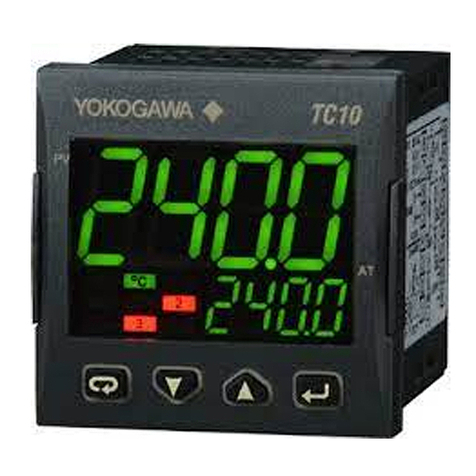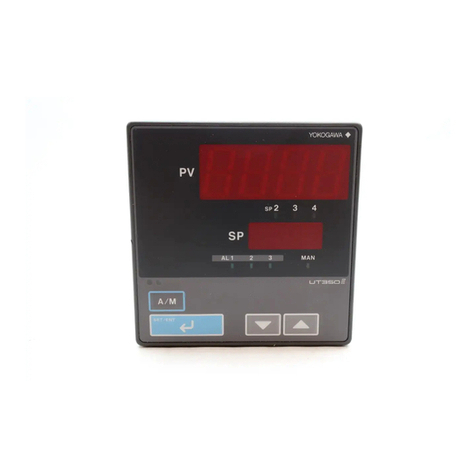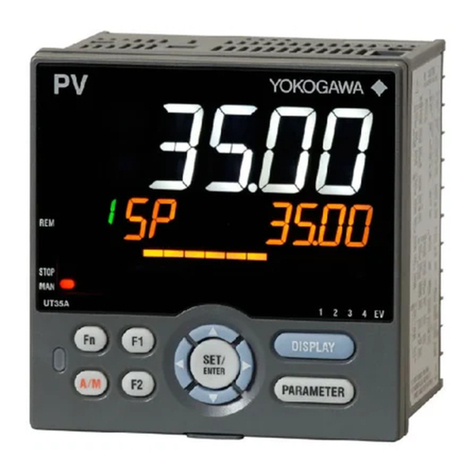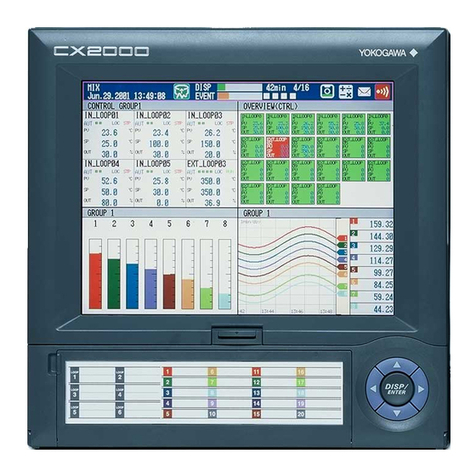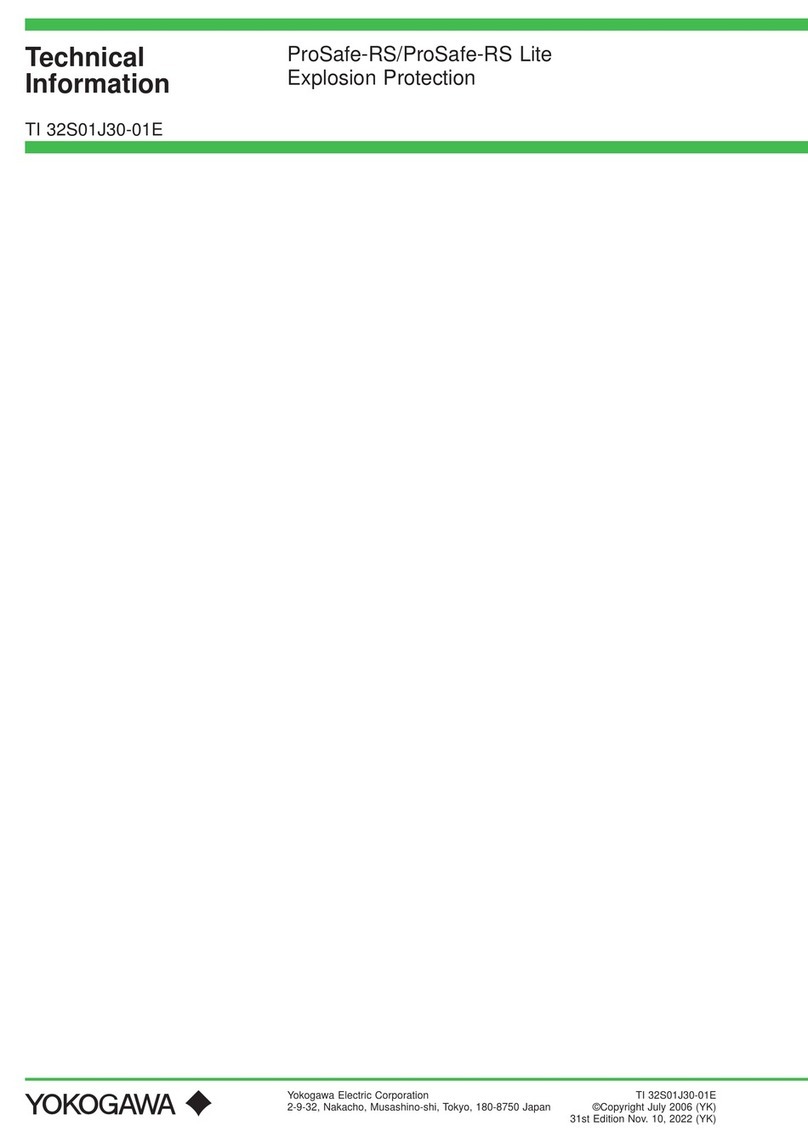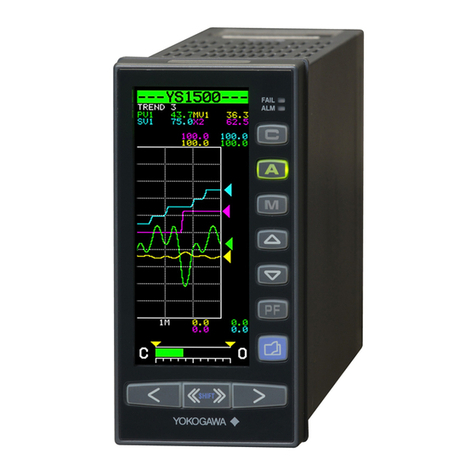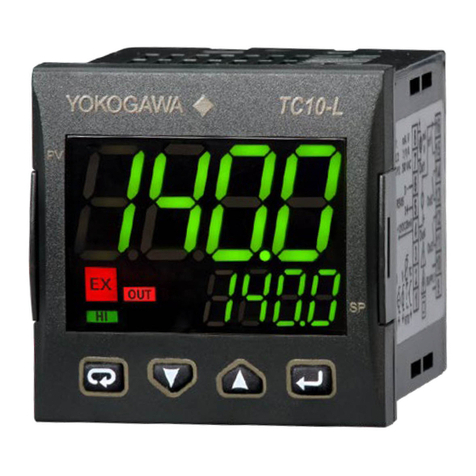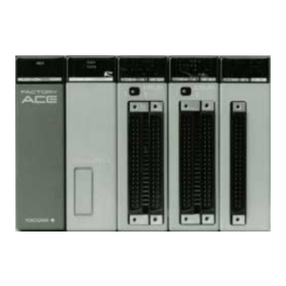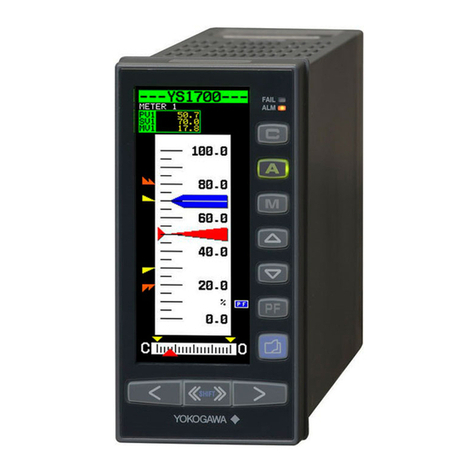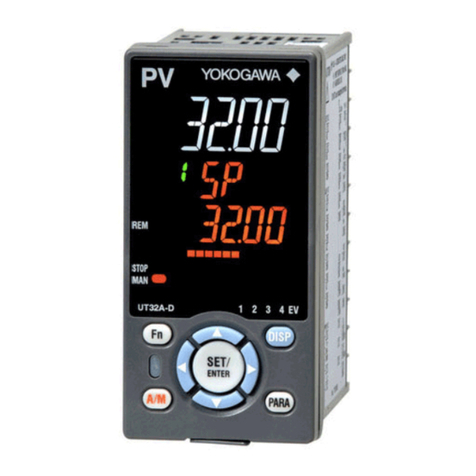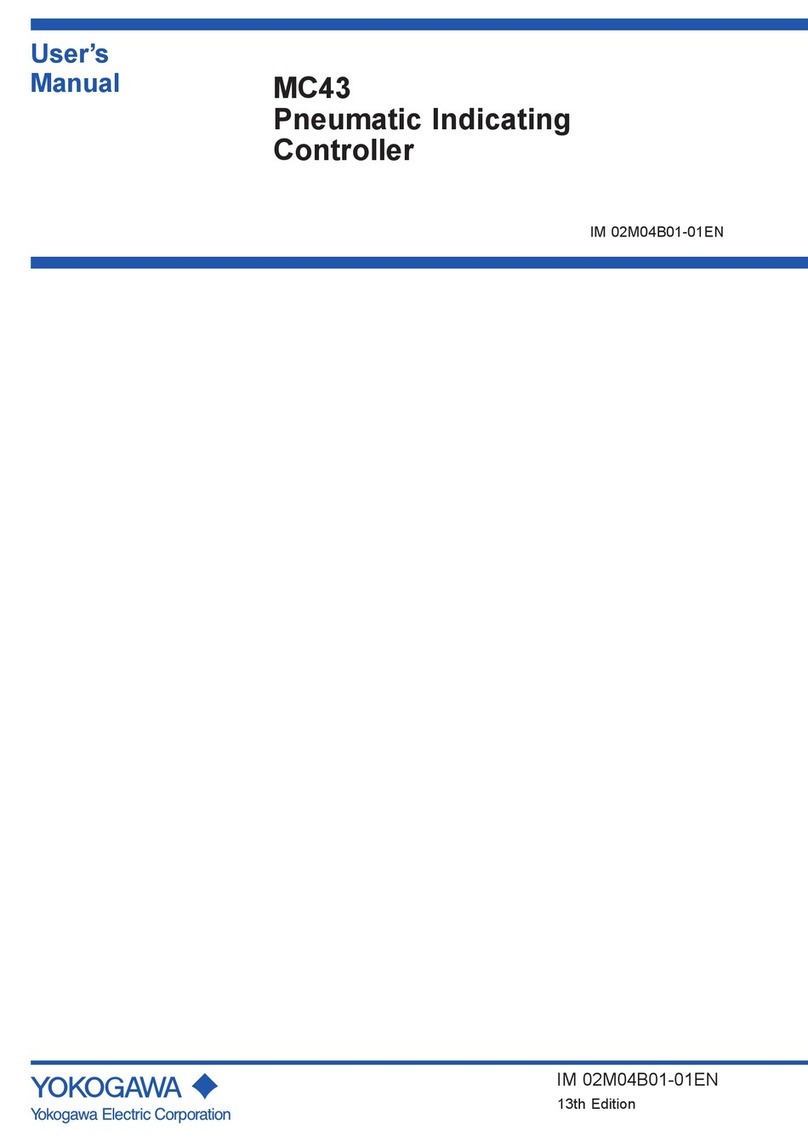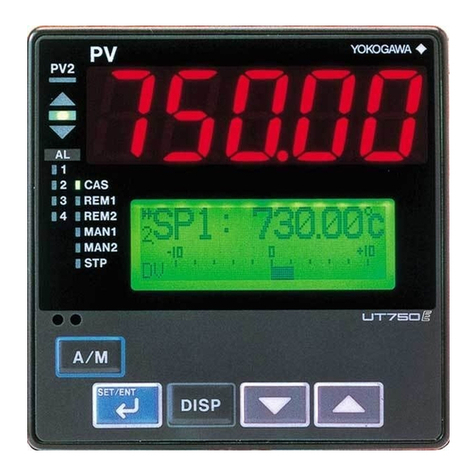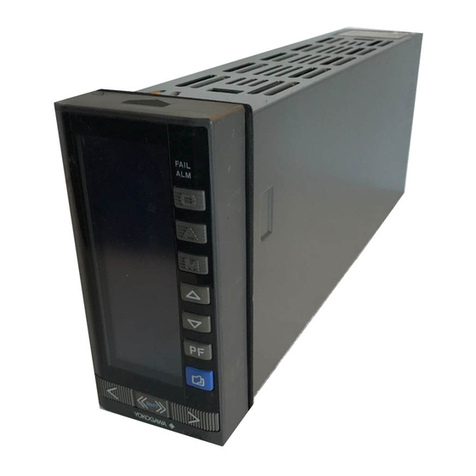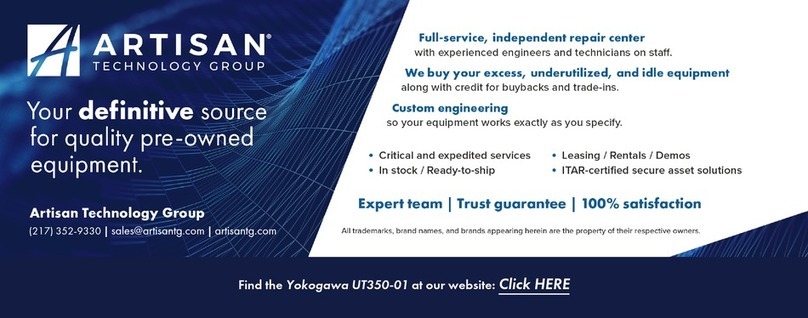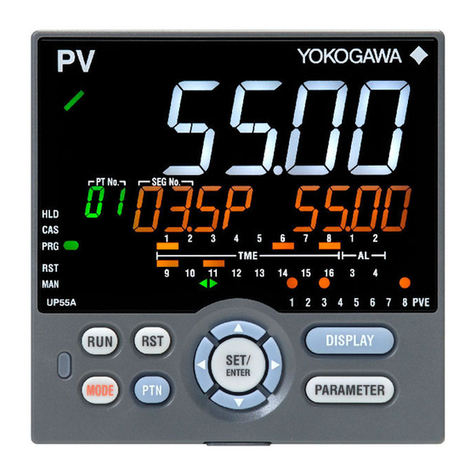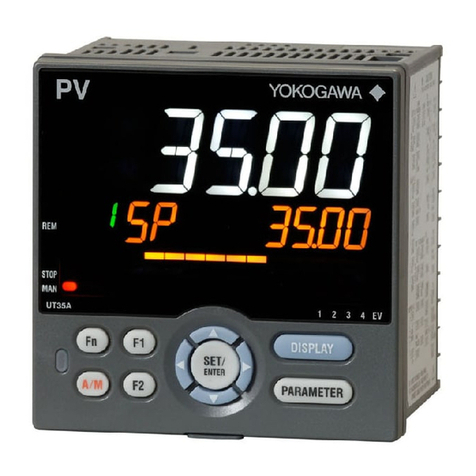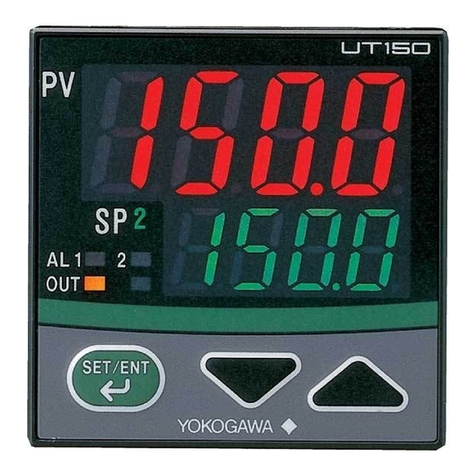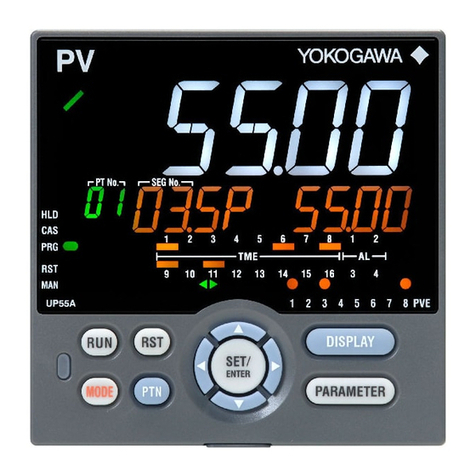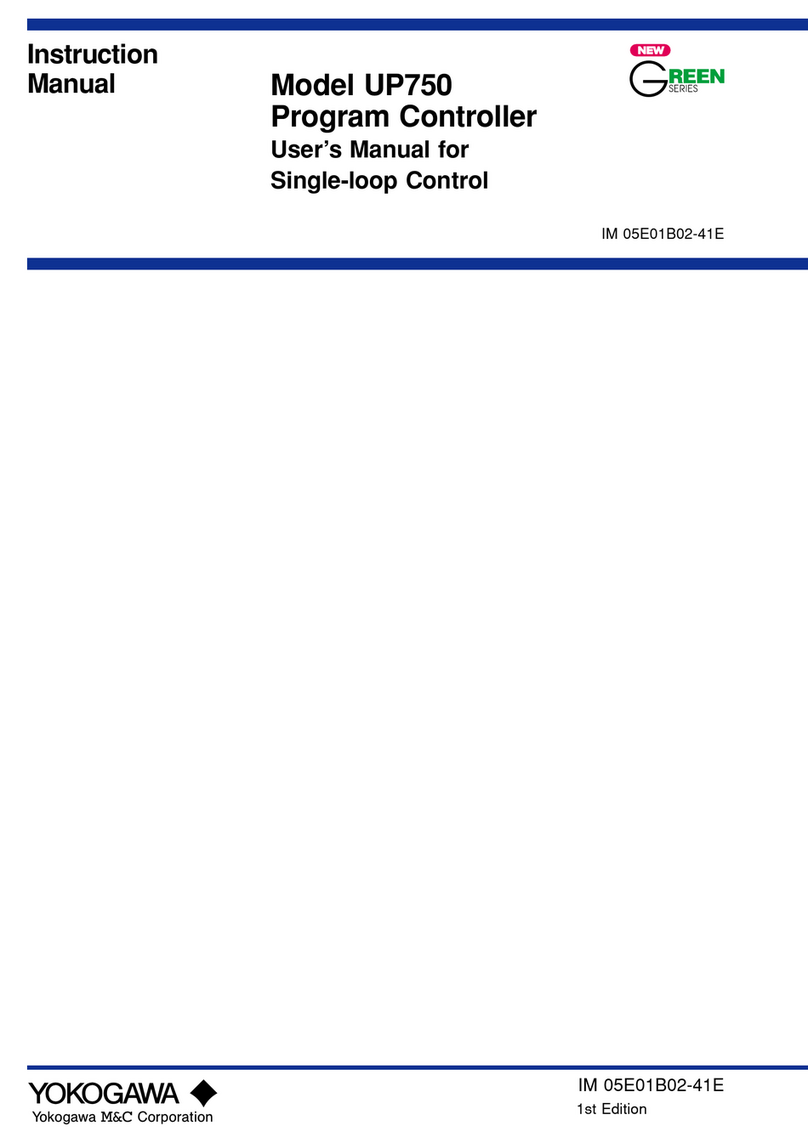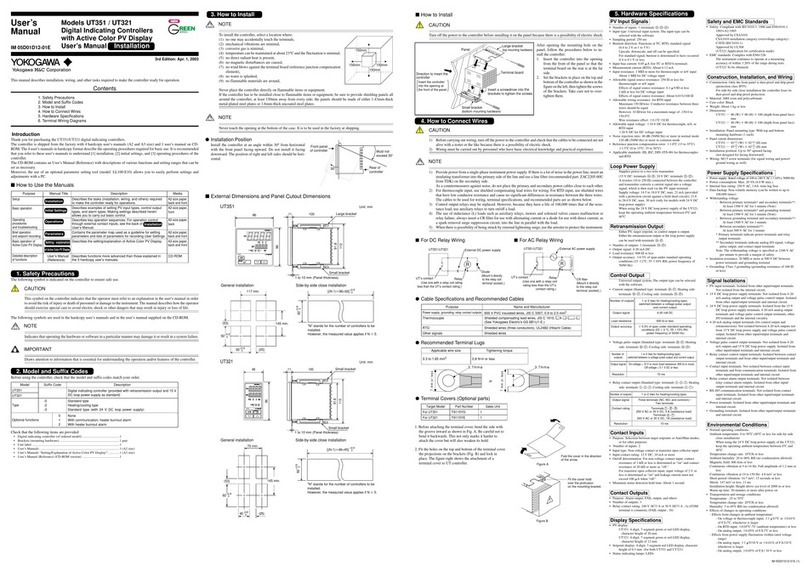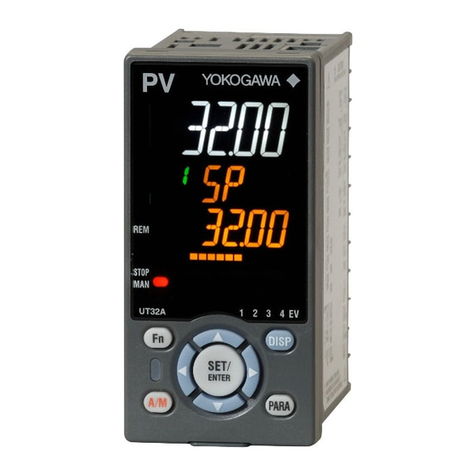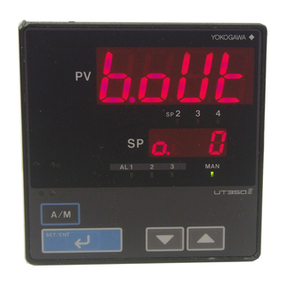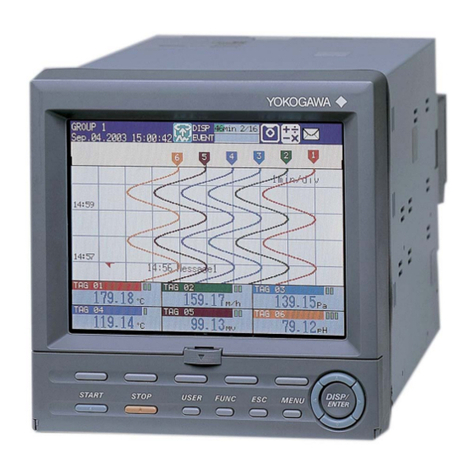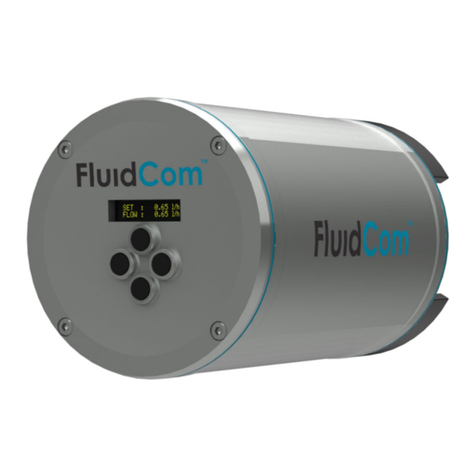
IM 05P01D81-11EN page 3/6
■ RelayContactOutputSpecications
• Contacttypeandnumberofoutputs:
Controloutput:contactpoint1c;1point
Heating/coolingtype:contactpoint1a;2pointsforbothheatingandcoolingsides
Alarmoutput:contactpoint1a;3points(commonisindependent)
• Contactrating:
Contactpoint1c(controloutput):250VAC,3Aor30VDC,3A(resistanceload)
Contactpoint1a(controloutput):240VAC,3Aor30VDC,3A(resistanceload)
Contactpoint1a(alarmoutput):240VAC,1Aor30VDC,1A(resistanceload)
• Use:Timeproportionaloutput,alarmoutput,FAILoutput,etc.
• Timeresolutionofcontroloutput:10msor0.1%ofoutput,whicheverislarger
Note:Thecontroloutputshouldalwaysbeusedwithaloadof10mAormore.
Thealarmoutputshouldalwaysbeusedwithaloadof1mAormore.
■ TransistorContactOutputSpecications
• Numberofoutputs:SeethetableofModelandSuxCodes.
• Outputtype:Opencollector(SINKcurrent)
• Outputcontactrating:Max.24VDC,50mA
• Outputtimeresolution:Min.200ms
• Use:Alarmoutput,FAILoutput,etc.
■ HeaterBreakAlarmSpecications
• Numberofinputs:2
• Numberofoutputs:2(transistorcontactoutput)
• Use:Measurestheheatercurrentusinganexternalcurrenttransformer(CT)and
generatesaheaterbreakalarmwhenthemeasured value islessthanthebreak
detectionvalue.
• Currenttransformerinputresistance:About9.4Ω
•
Currenttransformerinputrange:0.0to0.1Arms(0.12Armsormorecannotbeapplied.)
• Heatercurrentsettingrange:OFF,0.1to300.0Arms
Heatercurrentmeasuredvaluedisplayrange:0.0to360.0Arms
Note:TheCTratiocanbeset.CTratiosettingrange:1to3300
• RecommendedCT:CTfromU.R.D.,Ltd.
CTL-6-S-H:CTratio800,measurablecurrentrange:0.1to80.0Arms
CTL-12L-30:CTratio3000,measurablecurrentrange:0.1to180.0Arms
• Heatercurrentmeasurementperiod:200ms
• Heatercurrentmeasurementaccuracy:±5%ofcurrent transformer inputrange
span±1digit(CTerrorisnotincluded.)
•
Heatercurrentdetectionresolution:Within1/250ofcurrenttransformerinputrangespan
• BreakdetectionOn-time:Min.0.2second(fortimeproportionaloutput)
■ 24VDCLoopPowerSupplySpecications
• Use:Powerissuppliedtoa2-wiretransmitter.
• Powersupply:21.6to28.0VDC
• Ratedcurrent:4to20mADC
• Maximumsupplycurrent:About30mA(withshort-circuitcurrentlimitingcircuit.)
■ MaintenacePortSpecications
Themaintenanceportis usedtoconnectadedicatedcablewhenusingtheLL50A
ParameterSettingSoftware(soldseparately). Throughthisport,youcanset
controllerparameters,downloadladderprograms,andsoon.
Fordetails,seetheLL50AUser’sManual(IM05P05A01-02EN).
Dedicated cable
LL50A Parameter Setting Software
To USB terminal
Note
UseLL50Awiththecontrollerturnedon.(Thededicatedcablemustbeconnected.
LL50ALight-loaderadaptercannotbeused.)
ThemaintenanceportisnotisolatedfromthePVinputterminal.Usetheportonlyfor
maintenancepurposes,suchasforsettingthecontrollerparameters.
■ SafetyandEMCStandards
• Safety:
CompliantwithIEC/EN61010-1(CE),IEC/EN61010-2-201(CE),IEC/EN61010-
2-030(CE),approvedbyCAN/CSAC22.2No.61010-1(CSA),approvedbyUL
61010-1.
Installationcategory:II
Pollutiondegree:2
Measurementcategory:I(CATI)(UL,CSA)
O(Other)(CE)
Ratedmeasurementinputvoltage:Max.10VDC
Ratedtransientovervoltage:1500V(*)
*ThisisareferencesafetystandardvalueformeasurementcategoryIofCSA/UL61010-
1,andformeasurementcategoryOofIEC/EN61010-2-030.Thisvalueisnotnecessarilya
guaranteeofinstrumentperformance.
• EMCstandards:
CompliantwithCEmarking
EN61326-1ClassA,Table2(Foruseinindustriallocations),
EN61326-2-3
*Theinstrumentcontinuestooperateatameasurementaccuracyofwithin±20%ofthe
rangeduringtesting.
EN55011ClassA,Group1
EN61000-3-2ClassA
EN61000-3-3
EMCRegulatoryArrangementinAustraliaandNewZealand(forallmodelinclud-
ingLL50A)
EN55011ClassA,Group1
• KCmarking:
Electromagneticwaveinterferencepreventionstandard,electromagnetic wave
protection standard compliance
■ Construction,Installation,andWiring
• Construction:DINrailmountingtype
• Material:Polycarbonate(Flameretardancy:UL94V-0)
DINrailmountingbracketmaterial:Panelsteelsheet
• Casecolor:Black(Lightcharcoalgray)
• Weight:1kgorless
• Externaldimensions(mm):
UT35A/MDL:96(width)x114(height)x100(depth)
UT32A/MDL:48.2(width)x114(height)x100(depth)
• CompatibleDINrails:TH35-7.5Fe,TH35-7.5Aℓ,JISC2812
•
Mountingposition:Horizontal.
• Wiring:M3screwterminalwithsquarewasher(forsignalwiringandpowerwiring)
■ PowerSupplySpecicationsandIsolation
• Powersupply:
Ratedvoltage:100-240VAC(+10%/-15%),50/60Hz
24VAC/DC(+10%/-15%)(for/DCoption)
• Powerconsumption:UT35A:18VA(DC:9VA,AC:14VAif/DCoptionisspecied)
UT32A:15VA(DC:7VA,AC:11VAif/DCoptionisspecied)
• Databackup:Nonvolatilememory
• Powerholduptime:20ms(for100VACdrive)
• Withstandingvoltage
Betweenprimaryterminalsandsecondaryterminals:2300VACfor1minute(UL,CSA)
Betweenprimaryterminalsandsecondaryterminals:3000VACfor1minute(CE)
Betweenprimaryterminals:1500VACfor1minute
Betweensecondaryterminals:500VACfor1minute
(Primary terminals:Power*andrelayoutputterminals;Secondaryterminals:
AnalogI/Osignalterminals,contactinputterminals,communicationterminals
andfunctionalgroundingterminals.)
*:Powerterminalsfor24VAC/DCmodelsarethesecondaryterminals.
• Insulationresistance:Betweenpowersupplyterminalsandagroundingterminal
20MΩormoreat500VDC
• Isolationspecications
PV (universal ) input terminals / remote input terminals
Control relay (contact point c/contact point a x 2) output terminals
Alarm-1 relay (contact point a) output terminals
Alarm-2 relay (contact point a) output terminals
Alarm-3 relay (contact point a) output terminals
Contact input terminals (all)
RS-485 communication terminals
24 V DC loop power supply terminals
Contact output (transistor) terminals
Ethernet communication terminal
PROFIBUS-DP/DeviceNet/CC-Link communication terminals
Current transformer input terminals
Control, retransmission (analog) output terminals
(not isolated between the analog output terminals)
Internal
circuits
Power
supply
The circuits divided by lines are insulated mutually.
■ EnvironmentalConditions
Normal Operating Conditions:
• Ambienttemperature:-10to50°C
IftheCC-Linkoptionisspecied,0to50°CforUT35A/MDL;0to40°CforUT32A/
MDL.(side-by-sidemounting:0to50°CforUT55A/MDL;0to40°CforUT52A/MDL)
• Ambienthumidity:20to90%RH(nocondensationallowed)
• Magneticeld:400A/morless
• Continuousvibrationat5to9Hz:Halfamplitudeof1.5mmorless,1oct/minfor90
minuteseachinthethreeaxisdirections
Continuousvibrationat9to150Hz:4.9m/s2orless,1oct/minfor90minuteseach
inthethreeaxisdirections
• Short-periodvibration:14.7m/s2,15secondsorless
• Shock:98m/s2orless,11ms
• Altitude:2000morlessabovesealevel
• Warm-uptime:30minutesormoreafterthepoweristurnedon
• Startuptime:Within10seconds
*: TheLCD(aliquidcrystaldisplay)isusedforadisplayportionofthisproduct.
TheLCDhasacharacteristicthatthedisplayactionbecomeslateatthelow
temperature.However,thecontrolfunctionisnotaffected.
Transportation and Storage Conditions:
• Temperature:-25to70ºC
• Temperaturechangerate:20ºC/horless
• Humidity:5to95%RH(nocondensationallowed)
EectsofOperatingConditions
• Eectofambienttemperature:
VoltageorTCinput:±1µV/ºCor±0.01%ofF.S./ºC,whicheverislarger
Currentinput:±0.01%ofF.S./ºC
RTDinput:±0.05ºC/ºC(ambienttemperature)orless
Analogoutput:±0.02%ofF.S./ºCorless
• Eectofpowersupplyvoltageuctuation
Analoginput:±0.05%ofF.S.orless
Analogoutput:±0.05%ofF.S.orless
(Eachwithinratedvoltagerange)
5. How to Connect Wires
• Wiring work must be carried out by a person with basic electrical
knowledge and practical experience.
• Be sure to turn OFF the power supply to the controller before
wiring to avoid an electric shock. Use a tester or similar device
to ensure that no power is being supplied to a cable to be
connected.
• For the wiring cable, the temperature rating is 75 °C or more.
• As a safety measure, always install a circuit breaker (an IEC
60947-compatible product, 5 A, 100 V or 220 V AC) in an easily
accessible location near the instrument. Moreover, provide
indication that the switch is a device for turning off the power to
the instrument.
• Install the power cable keeping a distance of more than 1 cm
from other signal wires.
•
The power cable is required to meet the IEC standards concerned or
the requirements of the area in which the instrument is being installed.
• Wiring should be installed to conform to NEC (National Electrical
Code: ANSI/NFPA-70) or the wiring construction standards in
countries or regions where wiring will be installed.
• Since the insulation provided to each relay output terminal is
Functional insulation, provide Reinforced insulation to the
external of the device as necessary. (Refer to the drawing below.)
This product
Functional
insulation
A safety
voltage circuit
A safety
voltage circuit
This product
Reinforced insulation
Reinforced insulation
Functional
insulation
A hazardous
voltage circuit
A hazardous
voltage circuit
A safety
voltage circuit
A safety
voltage circuit
This product
Reinforced insulation
Reinforced insulation
Functional
insulation
A hazardous
voltage circuit
A hazardous
voltage circuit
A hazardous
voltage circuit
A hazardous
voltage circuit
CAUTION
• When connecting two or more crimp-on terminal lugs to the
single terminal block, bend the crimp-on terminal lugs before
tightening the screw.
• Note that the wiring of two or more crimp-on terminal lugs to the
single high-voltage terminal of the power supply and relay, etc.
does not comply with the safety standard.
CAUTION
• Provide electricity from a single-phase power supply. If the
power is noisy, install an isolation transformer on the primary
side, and use a line filter on the secondary side. When measures
against noise are taken, do not install the primary and secondary
power cables close to each other.
• If there is a risk of external lightning surges, use a lightning
arrester etc.
• For TC input, use shielded compensating lead wires for wiring.
For RTD input, use shielded wires that have low conductor
resistance and cause no significant differences in resistance
between the three wires.
• Since the control output relay has a life span (resistance load of
100,000 times), use the auxiliary relay to perform ON/OFF control.
• The use of inductance (L) loads such as auxiliary relays, motors
and solenoid valves causes malfunction or relay failure; always
insert a CR filter for use with alternating current or a diode for
use with direct current, as a spark-removal surge suppression
circuit, into the line in parallel with the load.
• After completing the wiring, the terminal cover is recommended
to use for the instrument.
● RecommendedCrimp-onTerminalLugs
(F)
3.3
Recommendedtighteningtorque:0.6N·m
Applicablewiresize:Powersupplywiring1.25mm2or more
Applicable terminal lug Applicable wire size mm2(AWG#) (φd) (A) (F)
M3 0.25to1.65(22to16) 3.3 5.5 4.2
● CableSpecicationsandRecommendedCables
Purpose Name and Manufacturer
Powersupply,relaycontactoutputs 600VGradeheat-resistantPVCinsulatedwires,JISC
3317(HIV),0.9to2.0mm2
Thermocouple Shieldedcompensatingleadwires,JISC1610
Forthermocoupleinput(PVinputandremoteinputwithdirect
input),shieldedcompensatingleadwireofcross-sectionalarea
lessthanorequalto0.75mm2isrecommended.Ifthecross-
sectionalareaiswide,thereferencejunctioncompensation
errormaybelarge.
RTD Shieldedwires(three/fourconductors),UL2482(HitachiCable)
Othersignals(otherthancontactinput/output)
Shielded wires
Othersignals(contactinput/output)
Unshieldedwires
RS-485communication
Shielded wires
Ethernetcommunication
100BASE-TX(CAT-5)/10BASE-T
PROFIBUS-DPcommunication
DedicatedcableforPROFIBUS-DP(Shieldedtwo-wires)
DeviceNetcommunication
DedicatedcableforDeviceNet(Shieldedve-wires)
CC-Linkcommunication
DedicatedcableforCC-Link(Shieldedthree-wires)
PROFIBUS-DP/CC-LinkConnector(wiringside)(Partnumber:A1987JT)
DeviceNetConnector(wiringside)(Partnumber:L4502BW)
Recommendedtighteningtorque:0.5to0.6N·m
DC Relay Wiring
R
External DC power supply
Relay
UT’s contact
Diode
(Mount it directly
to the relay coil
Relay
(Use one with a relay coil rating
less than the UT’s contact rating.)
AC Relay Wiring
UT35A, UT32A
R
CR filter
(Mount it directly
to the relay coil
terminal (socket).)
External AC power supply
Relay
(Use one with a relay coil
rating less than the UT’s
Transistor Output Wiring
+ –
DO
Load
COM
